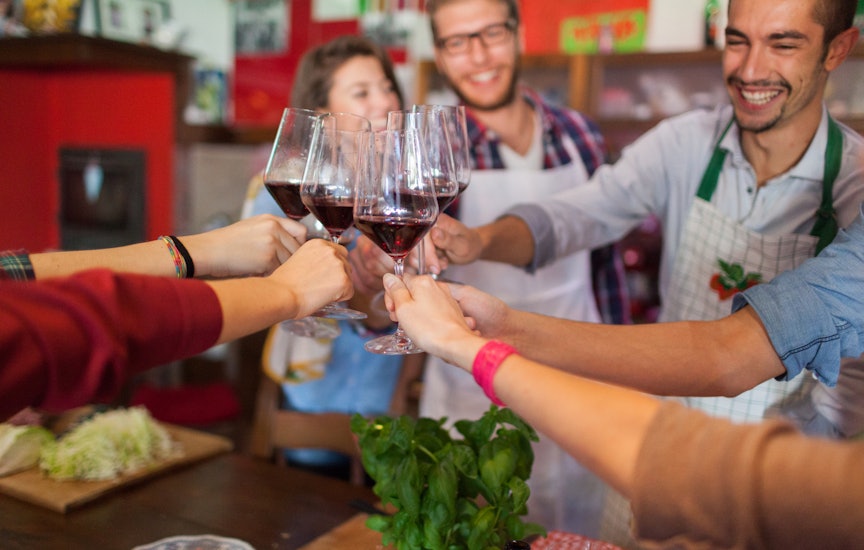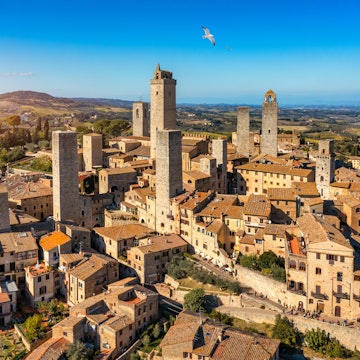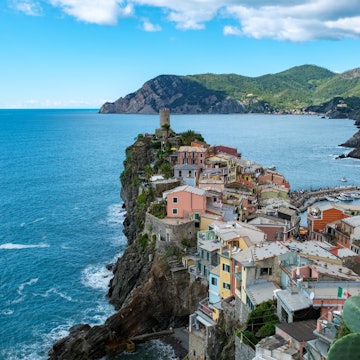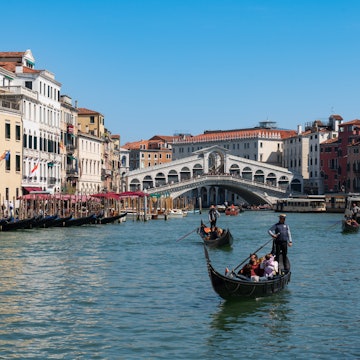
Hiding right in the elegant shadows of Venice's Grand Canal palaces and must-see monuments are Venetians' most beloved hangouts. But from the major tourist thoroughfares, you may only glimpse Venetians as they slip under archways into labyrinthine calli (backstreets), or hear their soft, assured footsteps gliding over Istrian stone footbridges.
Follow their lead, and you may feel like Alice following the white rabbit into Wonderland. To get to know Venice as Venetians do, you don't actually need to imbibe any magic potions - though every true Venetian adventure begins and ends with a glass of Prosecco. Just follow this guide, and you'll know where to go morning, noon and night in Venice.
Morning: Rialto
When tour guides refer to the Rialto, they usually mean the Rialto Bridge, Antonio da Ponte's dazzling Renaissance span across the Grand Canal. But when Venetians refer to the Rialto, they are usually referring to the Rialto Markets. These historic markets date from Venice's founding circa 809AD, when Venice was just a Byzantine backwater with no palaces but fish and ambition to spare.
The current Pescaria (fish market) is the 19th-century incarnation of an original Venetian fish market that lasted at least 600 years, until constant pounding finally wore out the paving stones. Beneath the stone fish gargoyles on the peaked roof, sustainable lagoon fishing standards are literally set in stone on a carved sign, and shameless bragging about Venetian moeche (soft-shell crab) and moscardini (baby octopus) still rises to the rafters by 5am Tuesday through Sunday.
By late morning, fishermen up before 3am are good and ready for their midday meal with a glass of Prosecco. Join them near the Pescaria and the Rialto produce stalls at backstreet bacari, hole-in-the wall pubs that have served Rialto marketeers steadily for up to 500 years. Pre-noon arrivals at All'Arco (Calle dell'Arco, San Polo 436), Pronto Pesce Pronto (Pescaria, San Polo 319) and Dai Zemei get first pick of ultra-fresh cicheti, or Venetian tapas: delectable, market-inspired bites of lagoon seafood, cured meats, cheeses and creative salads.
While away the hours between markets and meals shopping the artisan's studios alongside Rialto bacari. Lagoon ripples are perfectly captured in marbled-paper handbags at Cartè (www.cartevenezia.it); stationery letter-pressed with gondolas rolls hot off the antique press at Veneziastampa (www.veneziastampa.com); and Cartevenezia (www.cartavenezia.it) illuminates handmade paper lanterns with an embossed lion of St Mark, Venice's patron saint.
Afternoon: Zattere
In the neighbourhood of Dorsoduro, the banks of the Grand Canal are lined with art museums, from Tiepolo's glorious baroque ceilings at Ca' Rezzonico to Maurizio Cattelan's cheeky horse's hind end apparently jumping through the brick walls at avant-garde Punta della Dogana. But duck around the corner to the Giudecca Canal bank known as the Zattere, and you'll find sunset strollers and sun-tanning Venetians who can't be bothered to take the 15-minute boat ride to sandy Lido beaches.
Along this sunny stretch is the Magazzini del Sale (www.fondazionevedova.org), the historic salt warehouses recently reinvented by Renzo Piano and the late, great Venetian expressionist painter Emilio Vedova as a public gallery, hosting local talents alongside international artists like Anselm Keifer and Louise Bourgeois. Heading west Zattere past the Fondamenta degli Incurabili (Canalbank of the Incurables), you'll pass local art students casually flirting in front of the ancient syphilis hospice that became Venice's Accademia delle Belle Arti (Academy of Fine Arts), recently graced with a dedication to the poet Joseph Brodsky. Along these canalbanks, Russian-born American Nobel Laureate wrote Watermark, his passionate ode to Venice - as the plaque says, 'He loved and sang this place.'
Turn off the Zattere to reach Chiesa di San Sebastiano, the tiny parish church covered floor to ceiling with masterpieces painted over three decades by Paolo Veronese. Legend has it that the Renaissance master found refuge here after fleeing murder charges in his hometown of Verona in 1555, and lavished this church with gratitude. Over a bridge from San Sebastiano is Calle Lunga San Barnaba, a narrow alleyway lined with some of Venice's most affordable pizzerias and osterie specializing in meat dishes - a rarity in this lagoon city.
Evening: Ghetto
As Venetians know, even the highest tide must eventually ebb - and so it is with the influx of day-trippers during Venice's high season. Conventional wisdom among crowd-phobes is to plan visits Venice anytime but during the June opening of Venice's Art Biennale (held in odd-numbered years), during the annual Venice Film Festival (September), and throughout the two-week masked bacchanal that is Venetian Carnevale (February). But they've got it wrong: to experience Venice like a Venetian, all you need to do is to stay overnight.
Less than one-third of all visitors to Venice stick around after sunset, missing out on romantic canalside dining and family-run guesthouses tucked away behind the Strada Nova pedestrian thoroughfare in Cannaregio. This picturesque neighborhood is home to Venice's loveliest brick Gothic church, the Tintoretto-adorned Chiesa della Madonna dell'Orto, as well as Venice's historic Ghetto.
The world's original Ghetto housed Venice's Jewish community from the 16th through 18th centuries, with refugees from the Inquisition across Europe expanding the neighborhood beyond its original island boundaries. Publishers in the Ghetto circulated the daring humanist philosophy that sparked Italy's Renaissance, and the Ghetto's learned doctors helped Venice develop the concept of quarantine that spared the city the worst ravages of the bubonic plague. The history-changing contributions of the Venetian Jewish community are now captured in the Ghetto inside Italy's first Jewish Museum, the Museo Ebraico.
Bridges to the Ghetto that were once officially closed at night are open for evening strollers to browse Ghetto bookstores, art galleries and antique shops - at least until cicheti arrive on the countertops of bars lining the Fondamenta degli Ormesini, the canalbank across from the Ghetto. Raise toasts with Venetians between acoustic music sets at Al Timon (Fondamenta degli Ormesini, Cannaregio), but don't be late for reservations at nearby Dalla Marisa (Fondamenta San Giobbe 652b): lagoon seafood and local meats are strictly bought fresh daily, and when they're gone, no one else will be seated. With the lively regular crowd of tugboat captains, celebrated architects and champion rowers, raise your glass to la bea vita, Venice's beautiful life.















